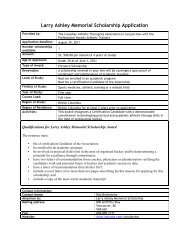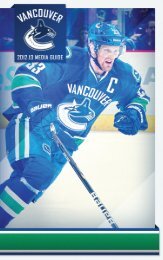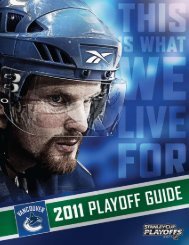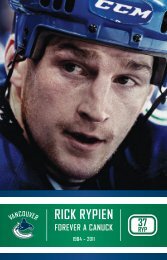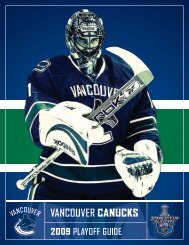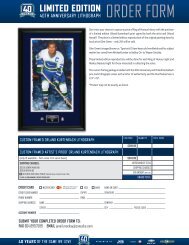October 29, 2010 - Vancouver Canucks
October 29, 2010 - Vancouver Canucks
October 29, 2010 - Vancouver Canucks
Create successful ePaper yourself
Turn your PDF publications into a flip-book with our unique Google optimized e-Paper software.
(*) On-ice shooting% differs from a shooters shot% in that all shots for his team when<br />
he is on the ice are counted as well, not just his own shots.<br />
Anyone who has observed the Sedins play for any length of time knows that they pass<br />
up shooting opportunities constantly, in order to create better quality opportunities with<br />
their sublime works of wizardous sedinery. For the most part, their style of play is<br />
exceedingly effective, partly because Daniel and Henrik are two of the leagues best<br />
passers.**<br />
(**) Among hockey analysts, shot location is a surprisingly controversial topic,<br />
considering how intuitive it seems conceptually. Gabe Desjardins, who runs<br />
behindthenet.ca, is among the more outspoken detractors of shot quality‘s analytical<br />
utility (or lack thereof), whereas others such as Tom Awad and Michael Shuckers,<br />
whose DIGR stat has captured many folks‘ attention recently, are convinced it matters.<br />
Because of the Sedins style of play and the quality of their passing, they have been able<br />
to perform alchemy and turn a number of replacement level top-six forwards into<br />
bonafide twenty-five or even thirty goal scrorers. Sometimes it seems as if my<br />
grandmother could pot twenty-five goals on the Sedins right-wing (granted, she‘s a<br />
feisty lady).<br />
I thought it might be fun to calculate the shooting percentage of every Sedin line-mate<br />
since the twins entered the league. I was wrong. It took a long time, was arduous and<br />
my findings are ultimately imperfect.<br />
Still, I think it‘s cool to look over, and allows me to make a basic point.<br />
While the list of Sedin triggermen isn‘t exactly awe inspiring, my hypothesis is that their<br />
shooting percentage will be. Sadly, some of the information I‘d require to do a more<br />
comprehensive table isn‘t available and so some assumptions will be required.<br />
First of all, I have no method of separating even-strength shots from PP shots until 07-<br />
08, which, is too bad and probably skews the numbers somewhat. To maintain<br />
consistency, I‘ve included PP goals and shots for most Sedin line-mates. This isn‘t a<br />
major flaw because most Sedin line-mates have also spent time on the man-advantage<br />
with the twins, with Alex Burrows being the most notable exception.<br />
Secondly, there are also gaps in what I‘m able to definitively figure out from the gamelogs<br />
and boxscores. For example, in 2001-2002, the Sedins lined up with Trent Klatt for<br />
34 games and with Todd Warriner for 13. That leaves 35 games unaccounted for, and<br />
as best I can tell the twins played with an irregular combination of wingers including<br />
Todd Bertuzzi, Jan Hlavac, Trevor Linden and Matt Cooke. It‘s impossible to ferret out<br />
who took which shot while they were on the ice with the twins, so I‘ve only included<br />
games in which the identity of the Sedin line-mate is clear. This means, sadly, that the<br />
likes of Jeff Cowan, Ryan Shannon and Mats Lindgren, all of whom I remember taking<br />
shifts here and there with the twins over the past decade, don‘t qualify for our list.<br />
The logic also results in us losing a few blocks of time: we lose from February through<br />
to the end of the season in 03-04 because Crawford never managed to find a good fit<br />
for the twins after Magnus Arvedson went down. He tried the likes of: Bertuzzi,<br />
Rucinsky, Naslund and Sanderson with the twins in search of a good fit and never really<br />
found one. Often the boxscore suggests that Bertuzzi would double shift and play 7 or





